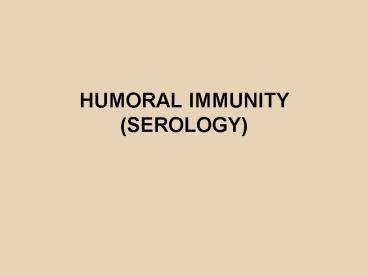Snmek 1 PowerPoint PPT Presentation
1 / 33
Title: Snmek 1
1
HUMORAL IMMUNITY (SEROLOGY)
2
GOOD LABORATORY PRACTICE (GLP)
rules and recommendation for operating of
clinical laboratories GLP includes
preanalytical phase analytical phase
interpretations and reefering of results
internal system of quality control external
system of quality control Accreditation of
clinical lab by State Health Authority
3
SEROLOGY
determination of immunological parameters in
body fluids (serum, plasma) optimal collection
and transport of sample (time) optimal
processing of sample
- centrifugation -
blood clot removal -
stabilisation of sample optimal storage of
sample - refrigeration short-term -
freezing - several month stability at 20C -
long-term stability at 70C or in liquid
nitrogen repeated freezing and thawing should be
avoided
4
IMMUNOCHEMISTRY
Immunochemical reaction (IR) specific
interaction between antibody (Ab) and
antigen (Ag) Antigen any molecule which is
immunogenic Antibody is raised in animal after
immunization
(antiserum) Characteristics of IR optimal
ratio of Ag and Ab (zone of equivalence)
optimal pH, ionic strength, temperature,
duration Immunochemical reaction
-
agglutination - precipitation
5
PRECIPITATION CURVE
Y
Y
Y
Y
Y
Y
Y
Y
Y
Y
Y
Y
Y
Y
Y
Y
Y
Y
Amount of precipitate
ZONE OF EQUIVALENCE
Excess Ab
Excess Ag
Amount of antigen
6
AGGLUTINATION
Ag is corpuscular (bacteria,
erythrocytes-hemagglutination, inert
particles-latex)) agglutinate is
formed agglutinate is visible by naked
eyes application limited to infection serology
(specific antibodies determination) application
limited to determination of autoantibodies
(rheumatoid factors)
7
PRECIPITATION
Ag is soluble Precipitation in semi-solid
medium (gel) visual determination in
fluid instrumental determination direct
determination of precipitates
turbidimetry, nephelometry indirect
determination of precipitates by secondary
antibody labeled by - enzyme EIA (enzyme
immunoassays) - isotope RIA (radio
immunoassays) - luminofore LIA
(luminiscence immunoassays)
8
2. PRECIPITATION
1. AGGLUTINATION
Ag CORPUSCULAR
Ag SOLUBLE
Y
Y
Y
Y
Y
Y
Y
IgM
IgG
Y
Y
BACTERIA
AGGLUTINATE FORMATION
PRECIPITATE FORMATION
9
DETERMINATION
- qualitative (presence)
- quantitative (how much) Quantitative
determination standard sample
(reference) dilution of standard
calibration curve
unknown sample Titer relative
quantification to express relative
amount of specific antibodies
reversed value of the highest dilution
of examined serum in which reaction
is positive (example dilution 1340 ?
titer 340)
10
TITER OF SPECIFIC ANTIBODIES
Ist step
50?l
50?l
50?l
50?l
50?l
50?l serum (Ab)
2
50?l dilution fluid
1
11
PRECIPITATION IN GELS
gel hydrated polysacharides (agarose) Ag (Ab)
or both diffuse through gel precipitation
lineages or rings are formed in zone of
equivalence simple and unexpensive
technique substantial delay in obtaining of
results (days)
12
SINGLE (RADIAL) IMMUNODIFFUSION (MANCINI)
antiserum is dispersed in gel precipitation
rings are formed area of ring is equivalent to
the concentration of antigen quantitative
determination (dilution of standard, calibration
curve)
13
SINGLE RADIAL IMMUNODIFUSION (SRID)
SERUM SAMPLE
difusion
Ag
difusion
PRECIPITATION RING (ZONE OF EQUIVALENCE)
GEL INCORPORATED ANTIBODY
14
DOUBLE IMMUNODIFFUSION (OUCHTERLONY)
qualitative determination both Ag and Ab
diffuse through the gel precipitation arc
(lineage) is formed
15
PRECIPITATION IN FLUID
most common approach now precipitates are
evaluated by optical system
turbidimetry
nefelometry most effective and rapid
automatisation, robotisation
16
(No Transcript)
17
IMMUNOGLOBULINS
are major blood proteins agammaglobulinemia hypoga
mmaglobulinemia hypergammaglobulinemia
- inflammation
- myeloma
18
DETERMINATION OF IMMUNOGLOBULINS
1. electrophoresis semiquantitative 2.
immunochemistry - radial immunodiffusion
-
turbidimetry, nephelometry
(IgG, A, M)
- ELISA (IgE) Normal ranges in
adults total IgG 6-17 g/l
IgA 1-4 g/l IgG1 3-9 g/l
IgM 0.5-3.0 g/l
IgG2 1-5 g/l IgG3 0.1-1 g/l
IgG4 0.01-0.9 g/l IgE class immunoglobulins
- present in a minute amount in serum (?g/l)
- detection by the sensitive immunoassay (ELISA)
19
ACUTE PHASE PROTEINS (APP)
Are plasma proteins which level is changed
during inflammation.
infection injury cancer
IL-1
APP
hepatocytes
macrophage
TNF?
20
ACUTE PHASE PROTEINS (APP)
reactants - plasma levels are increased in
inflammation - CRP
opsonisation -
?-orosomucoid -
?-antitrypsin - haptoglobin
- C3, C4 complement -
reactants - plasma levels are decreased in
inflammation - albumin
- prealbumin
- transferin
21
DETERMINATION OF ACUTE PHASE RESPONSE
erythrocyte-sedimentation rate (ESR) - reflects
the changes in APP (fibrinogen) - simple,
cheap electrophoresis - proteins have electrical
charge - migration of proteins in DC electrical
field - albumin (negative charge) ?-fraction
orosomucoid, antiproteases ?-fraction
transferin, C3 ?-fraction immunoglobulins, CRP
22
DETERMINATION OF ACUTE PHASE RESPONSE
electrophoresis - overall information about the
gross changes in the spectrum of
APPs immunochemistry - detailed information
about particular APP - function of APPs -
interpretation of results in the clinical context
23
IMMUNOELECTROPHORESIS
24
electrophoresis - proteins have electrical
charge - migration of proteins in DC electrical
field - albumin (negative charge) ?-fraction
orosomucoid, antiproteases ?-fraction
transferin, C3 ?-fraction immunoglobulins, CRP
25
(No Transcript)
26
(No Transcript)
27
DENSITOMETER
28
ELECTROPHORESIS
-
29
IMMUNOELECTROPHORESIS
immunoelectrophoresis combination of
electrophoresis immunodifusion immunofixation mo
dern approach more sensitive identification of
plasma or serum proteins immunoelectrophoresis es
sential for detection of paraproteins
30
NORMAL AND ABNORMAL B CELLS DIFFERENTATION
Ag INDEPENDENT
Ag DEPENDENT
PLASMA CELLS
UNMATURE B-CELLS
MATURE B-CELLS
CD 38
POLY-CLONAL RESPONSE
HLA DR
CD 19
HLA DR
Ag STIMULUS T HELP ISOTYP. SWITCHING AFFINITY
MATURATION
Ig GENES REARRANG.
TdT
BcR
CD 19
MYELOMA CELLS
GENETIC DAMAGE ACCUMULATION
CD 56
HLA DR
CD 38
CD 19
MONO- CLONAL RESPONSE (PARAPROTEIN)
MALIGNANT TRANSFORMATION
BcR
31
PARAPROTEIN
abnormal monoclonal immunoglobulin produced by
clone of malignantly transformed plasma cell
(plasmocytoma) macroglobulinemia (Morbus
Waldenström) lymphoma infiltrating lymphoid
tissues paraprotein is of IgM class plasma
viscosity multiple myeloma (M.M.) localisation
of plasmocytoma cells in bone marrow osteolytic
lesions paraproteins of IgG, IgA, IgD and IgE
(in decreased frequency) light chain
disease monoclonal light Ig chains (kappa,
lambda) secreted in urine as Bence-Jones protein
32
ELECTROPHORESIS
-
lane 3 susp.
paraprotein lane 7, 8
susp. paraprotein other lane
polyclonal immunoglobulins (normal)
33
IMUNOFIXATION
-
lane 1 monoclonal
protein (electrophoretogram)
lane 4, 5 immunochemical evidence
of paraprotein
IgM?
INTERPRETATION Waldenström
macroglobulinemia

